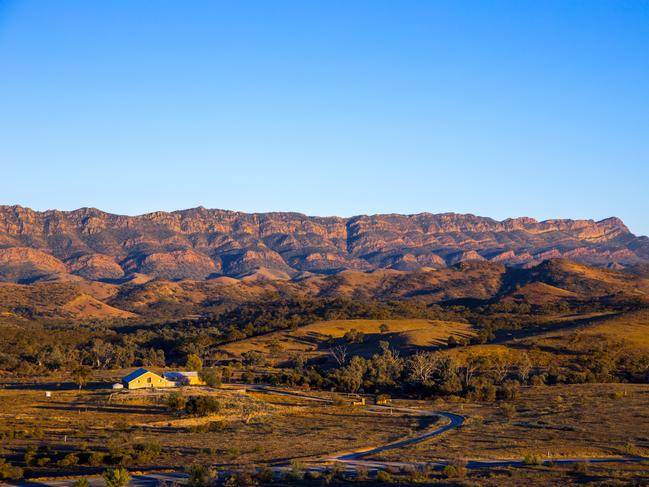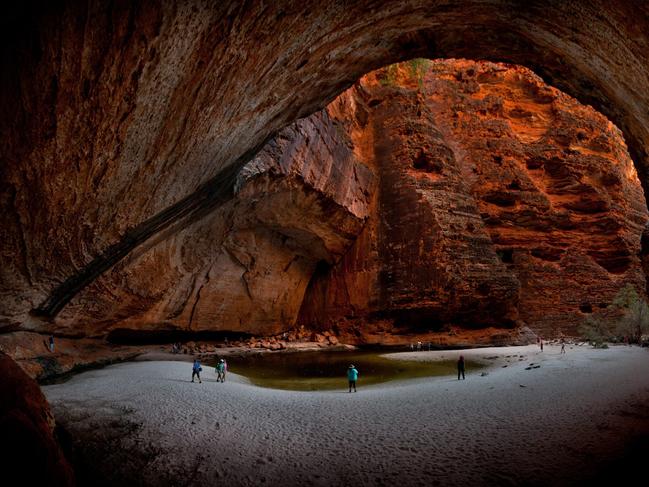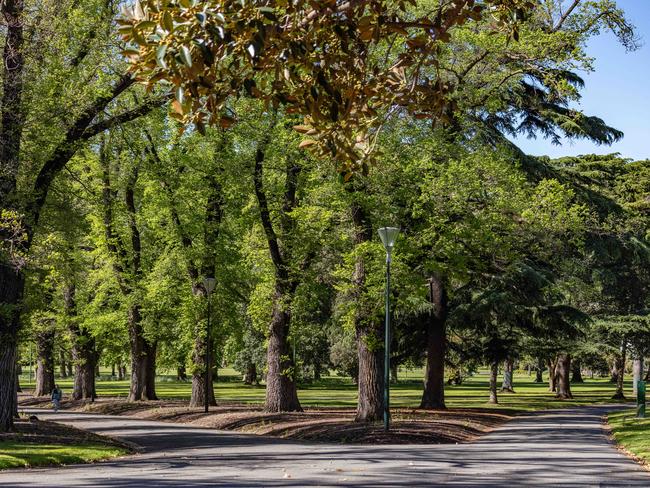Barry Humphries: Let me show you Australia
At school we were taught that Australia is boring. Now I want to take travellers to the Kimberley, the Flinders Ranges – and even to Moonee Ponds.

Australia is the most boring country in the world. That’s what we were taught at school. I attended the most expensive school in the southern hemisphere and I was educated by the cheapest schoolmasters in Melbourne. They were a collection of dotards and ignoramuses, but the school’s academic reputation was rescued by its generous quota of bright scholarship boys. The headmaster kept a little black book containing the names of boys who had “done well”.
It was a very thin little book.
Australian history and geography were crammed into a brief period after lunch on Thursday. (Does anyone study geography anymore? It’s probably been replaced by gender studies and colonial horror stories.)
During our Australian history period, we all fell into a deep post-prandial torpor. Bleak tales of bearded explorers dying of thirst and being speared by Aborigines convinced us to never, ever venture into that place far away called “the Outback”.
The Outback seemed a lot further away than Winnipeg, a place we learnt a great deal about.
We also learnt a lot about Huddersfield and Wolverhampton, too, and we could pinpoint them on a map of England and tell you their populations and their principal products. After all, England was “home” and Canada – with its Mounties, beavers and Winnipegs – was sort of family. We really thought New Zealand or even Tasmania didn’t count and usually left them off the map altogether.

We had a house on 30 acres of bush at Healesville, 41 miles from Melbourne. My parents thought it was safe in the event of a Japanese invasion – but the wildlife was considered to be the principal danger. Snakes lurked under every log and the old albums are full of snaps of my grandfather proudly displaying a decapitated serpent (usually a harmless one) writhing on his shovel or pitchfork.
Redback spiders were another venomous hazard, enjoying their traditional habitat under the wooden seats of all outdoor privies. Perhaps this was the reason so many of my contemporaries were constipated.
It was little wonder that my generation took the first opportunity to get out of Australia.
Of course, I had a parallel fascination and even affection for my homeland. I had an anthropologist’s interest in the suburban life of my home town and the quaint displaced “Englishness” of Melbourne with its thatched cottage teapots and Winston Churchill calendars behind the kitchen door. It all seemed, to my snobbish young self, an untapped reservoir of comedy. So, thankfully, it has proved to be.
It was only after long expatriation and several marriages that I began to really love Australia.
“Let me show you Australia,” I proudly announced to my present wife, Lizzie, one reckless moment 30 years ago. But what could I show her? I glumly reflected. Where had I been? Only the cities on theatrical tours. They I knew well, and I loved their variety. Now, alas, their uniqueness has been ironed out by developers, town planners and venal local governments. Skyline-itis has won out.

Every time I turn on the television someone is touring Australia with a film crew, in the footsteps of Alan Whicker, Billy Connolly, Jane McDonald and others. Now, the excellent Michael Portillo is dashing around by train, Martin Clunes, the great actor, is exploring some little-known islands, and even Miriam Margolyes has taken us on a personal tour. All have been entertaining but why, I sulkily inquire, have none of these production companies approached the obvious guide to Australia … me? Moi!
All these celebs touring Australia announce they’re on “a journey to discover …” and some of them are friends, or admired actors, but in the hands of hopeless researchers and directors who are often clueless about Australia. When Portillo strolled through the port of Fremantle, I kept yelling at the TV set, “ Turn right, turn right, and you’ll see our first convict-built church!” or something like that, or “What about the wonderful Fremantle Markets?” But he couldn’t hear me and, anyway, he had a train to catch.
So where would I, Mr Know-all, take you?
First to Moonee Ponds, the Melbourne suburb and home of Dame Edna Everage when, in 1954, I first introduced this intensely shy housewife and mother to the public. I had never visited Moonee Ponds. It was “on the wrong side of the tracks” and, paradoxically, only known for its proximity to the racetrack.
It is the only place name in Australia conflating an Aboriginal with an Anglo-Saxon word. Like Trollope’s Barchester, Hardy’s Casterbridge and Jessica Fletcher’s Cabot Cove, it has acquired near-mythical status, and I am told that Moonee is the preferred destination of Japanese tourists.

When John Betjeman visited Melbourne in the early ’60s, he was thrilled to discover that his route to the aerodrome passed through Moonee Ponds.
Qantas now flies direct to Darwin in a ridiculously short 15 hours and 40 minutes.
It’s not such a long trip when you think how long it takes to drive into the West End of London, allowing time for a heated dispute in Oxford St with an Andalusian jay walker and nearly killing a Kamikaze wobbling along on a scooter with a kid and a mobile phone. But think of all those snacks and snoozes on your flight and all those movies you’ll never remember.
From Darwin, you take a small plane east to Mount Borradaile. There is no hotel there, but nice facilities under canvas and romantic excursions in the pristine landscape.
When you go there, it’s like being present at the creation of the world, a magical and luxuriant Garden of Eden.
I remember an immense flooded plain, abundant with birds, luxuriant flowers and waterways. And in the distance, a pair of elegant dancing brolgas.
It is the least spoiled place I’ve ever been. The boat trip is imperative but abjure the pleasure of trailing your fingers over the side in the silky water. The crocodiles are vigilant and peckish. In Darwin recently, an 18-foot croc was found to contain 10 beautifully Revlon’d fingernails.
Of course, we’ll visit the old pearling town of Broome which was rediscovered by Margaret Thatcher’s treasurer, Alistair McAlpine, who reintroduced it to its indifferent inhabitants.
He saw beauty and value to which others were blind. He invented Broome. Please attend the Broome races – an attractive and youthful crowd of spectators and punters with refreshingly little respect for the sanctity of marriage. An eye-opener.

The Kimberley region in the upper northwest of WA is the real Australia; almost uninhabited, beautiful, wild, a desert in the dry season, savagely beautiful in the wet. And for a taste of the real Australian Outback, watch a TV program called Outback Truckers but preferably take a long holiday and go there.
The Flinders Ranges, north of Adelaide, is another rewarding destination. I often go there on painting expeditions in the footsteps of many other Australian landscape artists – some as accomplished as I.
On the way north to Wilpena Pound, a huge natural amphitheatre, stop off at Snowtown and see the old bank vault where the bodies of eight people were secreted in barrels by a severely challenged bunch of deviants.
Adelaide has been far too reticent in exploiting its exciting number of bizarre crimes and their locations – they are certainly of great interest to this tourist!
The Fitzroy Gardens, in Melbourne, is the place to see a phenomenon that has vanished from Europe: the elm.

Among those lovely, reprieved trees is Captain Cook’s cottage. It probably isn’t, but it was brought stone by stone from Yorkshire and then reconstituted in Fitzroy Gardens.
I was present one morning when a lady tourist and her daughter emerged from an inspection of the diminutive dwelling. “Well,” she said rather contemptuously, “they say he discovered Australia but all he had to do was look outside his front door!”
The most spectacular sight in Australia is not the Sydney Opera House, or the Great Barrier Reef, or the great red rock at Uluru. It’s the night sky in the Kimberley.
The air is so clean and so uncontaminated by the lights of cities that you will never have seen so many stars. They pullulate, they swarm, they are, well … awesome. And I employ that worthless epithet correctly.
I invite you to recline in a deckchair, as I have, a thousand kilometres from the nearest shop, and gaze into the incandescent caverns of an enormous bonfire sending its sparks high up to mingle with the nebulae. They call it “the bush television”.
Barry Humphries is an ambassador for the UK/Australia Season 2021-22, ukaustraliaseason.com


